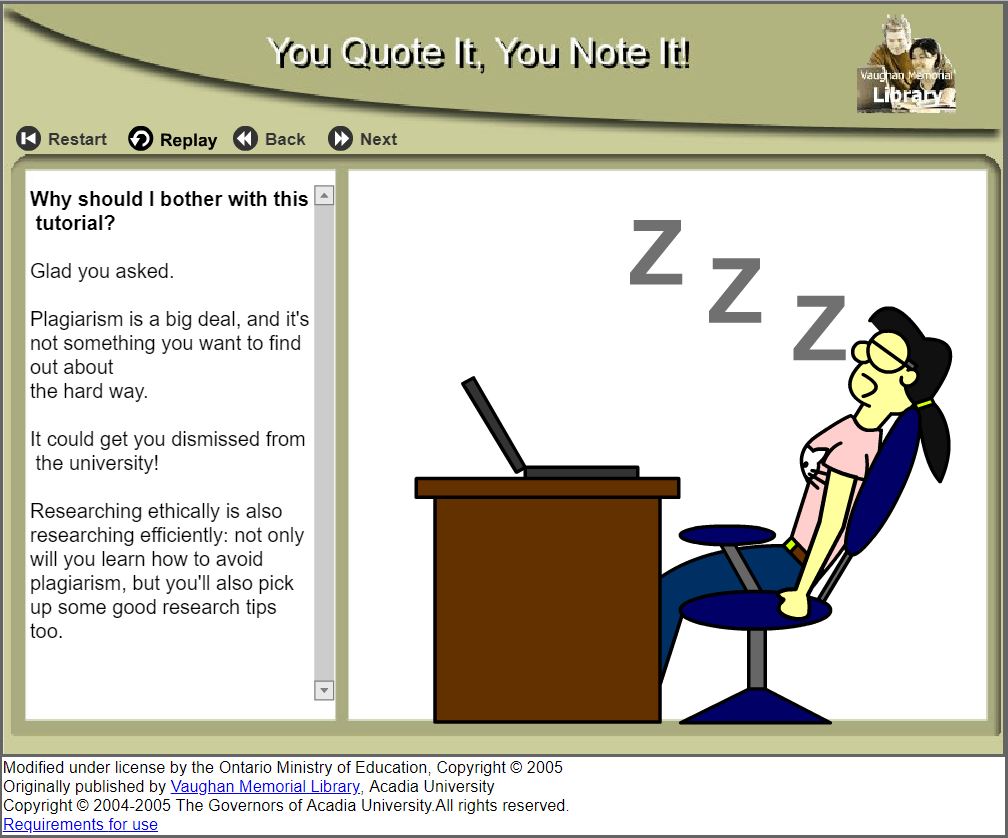Non-Fiction Texts
Chapter 2: To Thine Own Self Be True
MINDS ON
 Vocabulary 102
Vocabulary 102

By this point in your secondary school journey, you've probably heard of plagiarism. Plagiarism is similar to the dangers and obstacles that any hero would face - sometimes the dangers are obvious, while at other times they can be hidden. Depending on how your teachers have described it, you might think of plagiarism as being like a monstrous villain or a villainous monster. Fortunately, in this activity you'll learn and earn the tools necessary to not only recognize the monster, but also to slay it!
Of course, plagiarism isn't only a concern in secondary school - it matters in the "real world" as well. Beyond the serious consequences plagiarizing in university and college can have on your grades, your future career goals, or even your personal finances, being accused of plagiarism can have negative (and, thanks to social media, long-lasting) consequences on your reputation.
There are many famous cases where academics, authors, celebrities and content-creators were found to have plagiarized. Fortunately, there are plenty of paths that lead away from plagiarism, but, like all other paths, they are easier to follow when you know the signs. And, to quote from Frank Herbert's wonderful sci-fi and bildungsroman (definition:This is a type of novel or text concerned with the education, development, and maturing of a young protagonist.)epic, Dune, "knowing that a trap exists is the first step in avoiding it." Given that, you will research a famous plagiarist. Hopefully, by learning from history, you will make sure that it doesn't repeat itself.
 Forewarned is Forearmed...
Forewarned is Forearmed...
Your task is to research a famous plagiarist and then create a summary of this person's story; there are some resources below that might help you, or you can search the Internet for 'famous plagiarists.'
Next, you should research the plagiarist and provide a clear but concise account of why you chose that person, who she/he was, what she/he did, and what happened because of it.
 Resources
Resources
- 5 Great People Who Plagiarized is an interesting article that shows that even people whom we admire can steal others' ideas (and get caught).
- Notable Cases of Plagiarism takes readers through a list of famous politicians and journalists who could not resist plagiarism's siren's song.
- 10 Famous Cases of Alleged Music Plagiarism reminds us that sometimes when we think a song sounds familiar, it's because it is.
 Sidequest 1: Sad Poetry Plagiarism
Sidequest 1: Sad Poetry Plagiarism
Most stories that feature heroes coming-of-age are also full of sidequests. (definition:This is a term often used in video games where there are specific, typically small, tasks which deviate from the main plot and are often not required to complete; however, by completing them the player gains experience that results in greater opportunities for future success.) Throughout your journey in this course, you will have many opportunities to increase your English experience by taking on these optional, but relevant, sidequests.
Read the article, The Sad Poetry Plagiarism Story from Canada: When the guy being torn down may not be a simple villain... and then answer this question in your Notebook: Do you agree or disagree with the statement "there ain’t no villains here?"
If you want to view any links in this pdf, right click and select "Open Link in New Tab" to avoid leaving this page. (View the original article.)
ACTION

Have you ever been lost? How did it make you feel? Though everyone's experiences are different, it's likely you felt some or all of the following emotions: fear, nervousness, anger, worry, or even hopelessness. Well, being accused of plagiarism, especially when you didn't mean to do it, can elicit many of the same feelings. After all, in a basic way, the person accusing you of plagiarizing is questioning your very honour.
Now, if you did intentionally plagiarize, the only option is to admit your wrongdoing and learn from your mistakes; no one is perfect, but owning up to your mistakes and making sure you take steps to avoid them in the future is a clear sign of maturity.
What if you didn't mean to plagiarize - or, you didn't plagiarize, at all? Well, though your initial reaction might be to run off into the forest, you probably know that's only a short term solution, and certainly not a good one. Instead, in this activity you will learn how to navigate the murky world of plagiarism so that you never have to worry about facing that accusation.
Reading Powers Activate!
Throughout ENG2D, you will be asked to find the main idea and supporting details in a variety of different texts. This is an essential skill for reading effectively, but it can also result in accidental plagiarism. Just because you wrote out the main idea and supporting details in your words doesn't mean that they were your original ideas. As such, it's important to always give credit where credit is due; doing this is called citing. You will learn more about citing and citations later on.
For now, let's review how to effectively identify the main idea and supporting details in a text.
 Identifying the Main Idea and Supporting Details
Identifying the Main Idea and Supporting Details
After watching how the detective solves the case, it's your turn to apply your own textual detective skills.
Read the following article, then identify the main idea and three supporting details. Use this template to record your work.
If you want to view any links in this pdf, right click and select "Open Link in New Tab" to avoid leaving this page. (View the original article.)
Listening Powers Activate!
Have you ever heard the saying "an ounce of preparation is worth a pound of cure?" It's a truism (definition:A truism is a statement that is obviously true and says nothing new or interesting.)that means that it's better to act ahead of time than to react afterward. With that in mind, you are going to watch a video to help you prepare for your journey to best plagiarism. Watch and listen carefully as there will be questions following it that will assess your ability to actively listen.
 Active Listening Self Assessment
Active Listening Self Assessment
Before you watch the video, consider some of the listening and comprehension strategies you could use to help understand the material after only one viewing. Take a moment to review the following active listening strategies and supports, and complete the self-assessment checklist.
If you want to view any links in this pdf, right click and select "Open Link in New Tab" to avoid leaving this page. (View the original article.)
 Avoiding Plagiarism
Avoiding Plagiarism
Now that you've watched the video, answer the following questions and submit them to your teacher. Although you may be tempted to watch the video again while answering them, it is important that you do not do this. Bear in mind that it's not necessary to answer them word-for-word from the video.
Questions:
- What is the title of the video?
- What literary device does the title utilize? How do you know? Is it effective? Why or why not?
- What is plagiarism?
- Why is it so easy to plagiarize today?
- What might happen if you plagiarize at college or university?
- Why does the narrator clear his throat before reading the full definition of plagiarism?
- What does it mean to put something into "layman's terms?"
- What does verbatim mean?
- What state does the video use to show an example of plagiarism in a report?
- For what is an in-text citation used? Describe the specific version of this used in the Pennsylvania example.
- List the four ways by which you can determine whether something needs to be cited.
- Other than someone's writing, what else do you need to cite?
- What is paraphrasing?
- Why don't you have to give credit for something that's considered "common knowledge?" Give your own example of common knowledge that does not require credit.
- What about the video did you find the most effective? Use specific examples.
- What about the video did you find the least effective? Use specific examples.
- Which active listening strategy did you use? How did it help you learn about plagiarism?
Now that you know more about plagiarism in general, it's time to learn some of the specific mistakes students make that result in plagiarism.
If you want to view any links in this pdf, right click and select "Open Link in New Tab" to avoid leaving this page. (View the original article.)
The Writing Process
One of the best ways to avoid plagiarizing is by ensuring you follow the writing process. (definition:This is the process involved in producing a polished piece of writing. The writing process comprises several stages, each of which focuses on specific tasks. The main stages of the writing process are: planning for writing, drafting, revising, editing, proofreading, and publishing.) Using it will give you many opportunities to not only check your work to ensure it's effective and polished, but also honestly yours or accurately cited.
WritingProcess
Throughout this course, you'll improve your writing using three related but different processes: proofreading, editing, and revising.
ProofreadEditRevise

Subquest 1: OSSLT and Graphic Texts
Throughout this course, you will conduct a series of mandatory subquests (definition: Subquests are a secondary quests that form part of a larger quest; they are often seen in video games) that will give you insight into what the Ontario Secondary School Literacy Test (OSSLT) asks students to do. As stated on the Education Quality and Accountability Office's (EQAO) website, the OSSLT "measures whether or not students are meeting the minimum standard for literacy across all subjects up to the end of Grade 9. Successful completion of the literacy test is one of the requirements to earn an Ontario Secondary School Diploma. All students across the province write this test on the same date, usually in late March each year." Even if you have already successfully completed the OSSLT, these subquests will help you review your reading and writing skills.
To learn more about what the OSSLT is all about, read the OSSLT Getting Ready Guide for Grade 10 Students from EQAO. (Original article)
If you want to view any links in this pdf, right click and select "Open Link in New Tab" to avoid leaving this page. (View the original article.)
OSSLT Reading Questions
When it comes to reading tasks, the OSSLT generally asks three types of questions.
- Direct: This is the simplest type of question to answer since the correct answer to the question can be found in the text. You would use the reading on the lines (definition:This is a reading strategy where the reader looks at the direct, actual words and ideas being expressed to find the information needed.)strategy to answer these types of questions.
- Indirect: These questions are slightly more difficult to answer since the correct answer is not explicitly (definition:Answers which are stated clearly and in detail, leaving no room for confusion or doubt.)stated in the text. In other words, you cannot put your finger on the exact answer. However, you may find evidence in the text from which you can infer (definition:Inferring involves drawing meaning from or reaching a conclusion using reasoning and evidence from a text, based on what the author states and implies in the text. Inferring also involves using what you, the reader, bring to the text from your prior knowledge and experience.)and interpret details. This is known as reading between the lines. (definition:This is a reading strategy where the information is suggested or implied by the text, but is not directly stated.)
- Personal Connection: These questions are the most challenging to answer since the correct answer is not found in the text because there is not a single “correct” prescribed answer. Textual evidence can still be used to support your opinion but everyone's textual evidence may vary. Answers will differ from person to person because the purpose of these types of questions is to ask you to use personal interpretations and experiences to connect with the text. When answering these types of questions, connect what you have read with what you already know, what you have experienced, and what your personal viewpoints are.
 Types of OSSLT Questions
Types of OSSLT Questions
Copy the information about the three different types of questions into your Notebook since you'll be using it throughout the course.
 OSSLT Reading Questions
OSSLT Reading Questions
To test your understanding, picture a situation where a person puts on a big, thick, stuffed blue jacket before going outside.

Now, answer the following questions:
- Direct: What colour is the jacket?
AnswerThe jacket is blue.
- Indirect: What season is it and why?
AnswerIt is winter because the jacket has a lot of padding to keep someone warm.
- Personal Connection: Describe a time when you didn't dress properly.
AnswerOne time when I didn't dress properly was when I forgot to put on my gloves before going skiing. It was so cold that it hurt my hands to touch the ski poles! Eventually, I had to go inside.
Now that you've refreshed your reading skills, it's time for your first subquest! During this subquest, you'll learn how to read and respond to graphic texts. A graphic text presents information in a summarized and concise manner. Graphic texts include graphs, diagrams, maps, charts, schedules, websites, manuals, instructions, pamphlets, brochures, newspapers, recipes, weekly church bulletins, movie posters and more.
Graphic texts
- inform readers in a concise, comprehensible, and visually appealing manner;
- illustrate the most important information;
- compare data;
- compare data over time;
- show relationships between sets of data; and/or
- illustrate frequency, correlation, and trends.
Before you read a graphic text to analyse its features, you must learn to preview a text effectively. Previewing a text is important in order for you to identify features and their purpose, get an overall impression of the text, and locate important information. An effective reading strategy used in previewing a text is skimming and scanning. Skimming and scanning is not reading for comprehension, but rather, finding specific information quickly from the text. This activity will show you how to skim and scan effectively.
SkimandScan
 Subquest 1: OSSLT and Graphic Texts
Subquest 1: OSSLT and Graphic Texts
For this subquest, you'll re-read the graphic text, The Plagiarism Spectrum, from Turnitin.com and create OSSLT-style questions and answers. After that, develop one direct question, one indirect question and one personal connection question. Make sure that you include the answers, as well.
If you want to view any links in this pdf, right click and select "Open Link in New Tab" to avoid leaving this page. (View the original article.)
Great work! You've mastered your first subquest! Now it's time to return to this activity's main journey and learn a specific skill to avoid plagiarizing. To complete this task, you can choose how you'd like to learn the material. Would you prefer to learn by:
- watching a video?
- reading an article?
- reading an infographic?
Now that you've learned more about citing properly using MLA, take a moment to review the standard requirements for avoiding plagiarism by completing this interactive activity. While you won’t be required to cite external works often, there will be times when it’s required. Therefore, it’s essential that you know how to do so properly.
